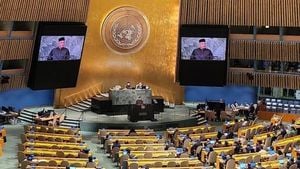President Donald Trump’s sweeping tariff policies have once again seized the spotlight, igniting fierce debate across financial markets, courtrooms, and the international stage. On August 8, 2025, Trump issued a stark warning on Truth Social: if U.S. courts overturn his tariffs, the country could tumble into an economic crisis reminiscent of the Great Depression of 1929. He wrote, “If a Radical Left Court ruled against us at this late date, in an attempt to bring down or disturb the largest amount of money, wealth creation and influence the U.S.A. has ever seen, it would be impossible to ever recover, or pay back, these massive sums of money and honor. It would be 1929 all over again, a GREAT DEPRESSION!” (Yahoo Finance).
Trump’s warnings come as a federal appeals court reviews the legality of his tariffs, which were enacted under the International Emergency Economic Powers Act (IEEPA) of 1977. The law allows the president to regulate importation during a national economic emergency, but critics argue Trump’s use of these powers may have overstepped legal boundaries. The U.S. Court of Appeals for the Federal Circuit heard arguments on July 31, 2025, with both Justice Department lawyers and attorneys for small business importers challenging the tariffs. The debate focused on whether the president’s declared emergencies—illegal immigration and the flow of illegal drugs—meet IEEPA’s “unusual” and “extraordinary” requirements (Yahoo Finance).
Legal observers, such as Alan Wolff of the Peterson Institute for International Economics, warn that overturning the tariffs could unleash a bureaucratic nightmare. Wolff described the refund process for affected parties as “a massive amount of red tape,” likening it to a bell that “cannot easily be fully unrung” (BlockNews). If the courts rule against the tariffs, the government could be compelled to refund billions in collected duties. Treasury Department data showed that $26.6 billion was collected in June 2025 alone, up from $22.2 billion in May, bringing the fiscal year’s total to $108 billion so far (Yahoo Finance). The final tally for July is still pending, but the stakes are clearly enormous.
Former House Speaker Paul Ryan has weighed in, suggesting that the Supreme Court may ultimately determine the fate of these duties. Trump, never one to shy away from political theater, speculated about the ideological makeup of the appellate judges, noting that seven were appointed by Democratic presidents and four by Republicans. “There is no way America could recover from such a judicial tragedy,” he wrote, underscoring the high drama and personal stakes he sees in the legal battle (Yahoo Finance).
Supporters of Trump’s tariffs argue that they have bolstered domestic manufacturing and helped reduce the U.S. trade deficit, aligning with the administration’s broader economic agenda. Trump himself claimed the tariffs have had a “tremendous positive effect” on the stock market, driving record highs nearly every day and generating “hundreds of billions of dollars in revenue for the U.S. Treasury” (TheBlockBeats). According to BlockNews, Trump insisted that striking down the tariffs would “disturb the largest amount of money, wealth creation and influence the U.S.A. has ever seen” and argued it would be “impossible to ever recover.”
Yet the financial markets tell a more nuanced story. On the day the latest tariffs took effect, the Dow Jones Industrial Average and S&P 500 both slipped, while the Nasdaq shot up—buoyed in part by anticipated exemptions for the semiconductor industry (Yahoo Finance, Yahoo). When Trump delayed “liberation day” tariffs in April 2025 for 90 days, the Nasdaq surged 7% within minutes, and semiconductor stocks such as AMD and Marvell rallied alongside Apple (BlockNews). These short-term rallies, however, tend to fade as policy uncertainty returns. The pattern is clear: markets react sharply to tariff news, but the boosts often prove fleeting as investors grapple with the administration’s unpredictable approach.
Market analysts have repeatedly emphasized the complexity and uncertainty introduced by Trump’s trade policies. CNBC reported that the investment environment has become “tricky,” with analysts advising investors to adopt more flexible strategies amid ongoing changes. The global market’s response has been mixed. While some investors in Asia and Europe have shown resilience, strong corporate earnings have helped stabilize sentiment even as concerns linger over the long-term impact of U.S. trade policy (The New York Times).
Critics of the tariffs warn of higher inflation, legal disputes, and strained international trade relations. Global trading partners have struggled to adjust to the new policies, leading to supply chain disruptions and short-term volatility (WAVE). The uncertainty has made life difficult for businesses and investors alike, with many keeping a wary eye on the next move from Washington.
Trump’s legal team has argued that a Nixon-era ruling on a law preceding the IEEPA supports the president’s authority to levy tariffs. The outcome of the current legal challenges could hinge on whether the courts accept this precedent. Meanwhile, the Justice Department and small business importers continue to spar over the limits of presidential power under IEEPA, with the future of billions in tariff receipts hanging in the balance (Yahoo Finance).
Amid the legal wrangling, Trump has framed the issue as both an economic and political fight. He has cited past accusations of judicial overreach against his administration and cast himself as uniquely qualified to navigate the “trials, tribulations and uncertainties” of the court system. “There is no one in history that has gone through the trials, tribulations and uncertainties such as I, and absolutely terrible, but also amazingly beautiful, things can happen,” he wrote (Yahoo Finance).
For now, the banking and business communities remain divided. Some see the tariffs as a necessary defense of American industry; others warn of the dangers of retaliation, supply chain chaos, and the ever-present risk of market instability. The courts’ decisions in the coming months could reshape not only the fate of Trump’s tariffs but also the broader landscape of U.S. economic policy and global trade relations.
As the legal and economic drama unfolds, investors and policymakers alike are left to ponder a question with no easy answer: Are Trump’s tariffs a shield for American prosperity, or a ticking time bomb for the global economy? The answer, it seems, will depend on the courts—and the unpredictable winds of politics and markets.






